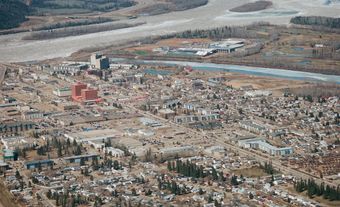Urban Studies
Urban studies is the study of Canada's urban development in all its diverse aspects, including the evolution of communities (urban history); city-building processes (urban geography, urban economics, planning, architecture); urban politics and government (urban political science); and urban society (urban sociology and anthropology, urban demography). Before the 1960s urban studies were dominated by geographers. In Québec, Raoul Blanchard and his students published numerous urban studies in the 1930s, 1940s and 1950s, while Jacob Spelt, Donald Kerr, J. Wreford Watson and others examined urban development in Ontario. Most studies concentrated on individual communities or regions and adopted one of 2 approaches: studies that singled out the urban aspects of the human-environment system, resulting in systematic studies of individual phenomena (urban-economic geography); and synthetic studies that attempted to achieve a holistic appreciation of the many interrelated phenomena that evolved over time to give a unique, urban character to the landscape (historical urban geography).
By the early 1970s many other disciplines had become involved in urban studies, and distinct subdisciplines emerged rapidly. This trend was marked by the establishment, for example, of the Centre for Urban and Community Studies at U of Toronto, the Institute of Urban Studies at U of Winnipeg, and the Institut national de la recherche scientifique (INRS) - Urbanisation in the U du Québec system. Activity in universities was not restricted to research centres; it also included the introduction or expansion of urban studies courses and teaching programs, and substantial growth in schools of URBAN AND REGIONAL PLANNING.
In government, distinct ministries of urban affairs at the provincial level were formed or expanded, and the federal Ministry of State for Urban Affairs was established (1971). These departments supported research and added to the well-established research programs of such bodies as the CANADA MORTGAGE AND HOUSING CORPORATION (CMHC) and the Canadian Council on Urban and Regional Research (CCURR). Several important projects were undertaken during the 1970s, including the publication of the Urban Profiles Series (1974-75) and the Urban Prospects Series (1975-76).
The urban studies environment was bolstered as well by the appearance of a variety of new journals, newsletters and magazines, including Urban Focus (1972), published by the Institute of Local Government; Urban History Review /Revue d'histoire urbaine (1972), published by the National Museum of Man; Urban Reader (1973), published by the city of Vancouver; Urban Forum (1975), published by CCURR; and City Magazine (1974), a commercial venture undertaken by Toronto publisher James Lorimer. In 1977 Micromedia of Toronto began to produce a quarterly index of publications in the urban studies field entitled Urban Canada/Canada urbain.
The increasing concern over urban issues was also evident at the municipal level. The Federation of Canadian Municipalities either undertook or sponsored urban research, while individual communities organized formal city archives. Preservation of the built urban heritage was another characteristic of the 1970s as many communities established committees and departments and passed by-laws dealing with preservation and conservation (see HERITAGE CONSERVATION; HERITAGE CANADA FOUNDATION).
Despite all this activity, no dominant theoretical or interpretative trends emerged in urban studies in the 1970s or early 1980s. Hundreds of books and articles were published, particularly at the community and regional levels. Books included N.H. Lithwick, Urban Canada: Problems and Prospects (1970); J. and R. Simmons, Urban Canada (1974); G. Nader, Cities of Canada (2 vols, 1975-76); J.N. Jackson, The Canadian City: Space, Form, Quality (1973); L. Stone, Urban Development in Canada (1967); D.J.H. Higgins, Urban Canada: Its Government and Politics (1977); J. Lorimer and E. Ross, The City Book (2 vols, 1976-77); L.O. Gertler, Planning the Canadian Environment (1968); G.A. Stelter and A.F.J. Artibise, eds, The Canadian City (1977) and Canada's Urban Past (1981); and A.F.J. Artibise and P.A. Linteau, The Evolution of Urban Canada: An Analysis of Approaches and Interpretations (1984).
By the early 1980s the attention devoted to urban issues was beginning to wane as a result of the recession and because many of the earlier initiatives had not - in the minds of politicians, at least - fulfilled their early promise. Thus the federal urban ministry was disbanded in 1979, several provincial urban ministries were reduced, urban research institutes foundered, and several urban studies journals and newsletters died. But although there was a notable decline in interest in urban studies, there remained a solid core of specialists.
By the 1990s, new energy and attention became focused on urban studies as a result of the growing environmental movement and the discussions of sustainability prompted by the World Commission on Environment and Development (WCED) report, Our Common Future (1987). Among the many issues identified by the WCED, cities and urbanization were discussed as key challenges in achieving a sustainable future. As a result, the growth of urban ecology has been dramatic, as indicated in the work cited in M. Roseland, Toward Sustainable Communities: A Resource Book for Municipal and Local Governments (1992). This renewed attention to the broad field of urban studies has taken the form of hundreds of reports emanating from all quarters: local, provincial and federal governments, and a wide variety of professional and citizen non-governmental organizations. A new national journal, Canadian Journal of Urban Research, was also begun at the University of Winnipeg.
See also CITY; URBAN DESIGN; URBAN REFORM; URBANIZATION.

 Share on Facebook
Share on Facebook Share on X
Share on X Share by Email
Share by Email Share on Google Classroom
Share on Google Classroom


